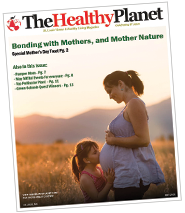story by Linda Wiggen Kraft
Thirty miles east of Kansas City is a garden called Heartland Harvest Garden. It is the largest public edible garden in the country. The garden is part of Powell Gardens, Missouri’s other botanical garden. There are over 900 acres to this botanical garden that opened in 1988, with twelve acres of harvest garden.
I wanted to visit the harvest garden since it opened in 2009. A few weeks ago I made the four-hour trip. Not only is the harvest garden beautifully designed, it grows edibles that work in our challenging climate, including this most challenging 2012. Some things showed the stress of this year, and others looked great.
The open landscape of this once farmland is the setting for the edible gardens. The first is the enclosed potager kitchen garden with four small beds surrounded by high wattle fence. Next, is the greenhouse with different varieties of hardy figs growing outside. Then a bright apple sculpture welcomes visitors to the brick walkway that spirals from the apple orchard. The red brick mimics Dorothy’s yellow brick road and honors her Midwestern and Kansas roots. The path goes from the apple orchard with over fifty different varieties, past the vineyard of fifty grape varieties, to the Authors’ gardens designed by edible garden gurus from California and Maine, through the pear orchard, to peach plaza with twenty-seven varieties of peaches and nectarines. The trail then continues on with shrubs, trees and vines that produce other fruit, nuts and berries. It ends at the quilt gardens where plants for farm animals and humans are planted in traditional Kansas and Missouri Star patterns. The final destination is the red barn and silo observation tower, which gives a full view of the quilt patterns and other garden areas.
The most interesting part of the gardens was the companion planting of fruit trees and plants growing under them. The companion plants, which included roses, clover, chives, strawberries, hyssop, perilla and others were planted to attracted beneficial insects, help with pollination, enrich the soil, increase yields and provide anti-fungal properties. Some of the apples that looked great included Starkspur Arkansas Black, Liberty, September Wonder Fuji, and Royal Empire. There were even late ripening peaches including Intrepid. Most other vegetables looked good despite the weather.
The trip was worth the drive, the edible gardens gave me lots of information for growing food. As for food for the soul, off in another part of Powell Gardens there is a chapel, designed by Arkansas architect Fay Jones. Built on a wooded hillside overlooking open rolling hills, the chapel’s organic open shape offered a quiet reflective space and a perfect way to end my visit.
Linda Wiggen Kraft is a landscape designer, mandala artist, photographer and meditation teacher. Her work can be seen on her website and blog. Please visit www.CreativityForTheSoul.com.


